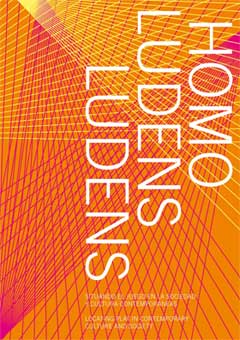 As promised two days ago, here’s more details about Homo Ludens Ludens, a new exhibition which reflects on the various roles fulfilled by play in our digital era. Homo Ludens Ludens opened on April 18 at LABoral the Center for Art and Industrial Creation which means that i was back in Gijon, Asturias, land of monster squids, rosy cheeks, deep-fried and vegetable-free diet, gorgeous landscapes and sidra thrown all over your favorite sneakers.
As promised two days ago, here’s more details about Homo Ludens Ludens, a new exhibition which reflects on the various roles fulfilled by play in our digital era. Homo Ludens Ludens opened on April 18 at LABoral the Center for Art and Industrial Creation which means that i was back in Gijon, Asturias, land of monster squids, rosy cheeks, deep-fried and vegetable-free diet, gorgeous landscapes and sidra thrown all over your favorite sneakers.
Homo Ludens Ludens is the last episode of a trilogy that LABoral is dedicating to the world of game. Following Gameworld and Playware, HLL explores play as a key element of today’ s world, highlighting its necessity for our contemporary societies. There are more than 30 works on show, so you can expect several installments about Homo Ludens Ludens.
The title of the show, Homo Ludens Ludens , alludes to the taxonomy of human evolution. The human being used to be regarded as a Homo faber (man the smith or man the maker in latin) for the control they could exert on the environment through tools.
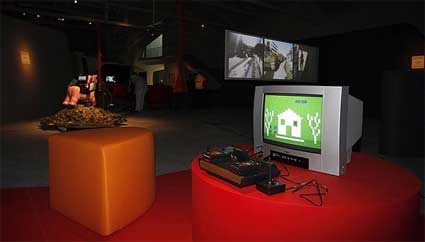 Image credit: LABoral/Enrique G. Cárdenas
Image credit: LABoral/Enrique G. Cárdenas
In 1938, however, Dutch historian Johan Huizinga introduced the idea that man is also an Homo Ludens (a “playing man”), a man for whom amusements, humour and leisure played an important role in both culture and society. Philosopher Vilém Flusser went further. For him, we are living in a society which, instead of working, generates information by playing with a technical apparatus, implying a transition from the myth of the creator towards a player. Playing can therefore be regarded as an act of emancipation.
The exhibition speculates on the emergence of a Homo Ludens Ludens – the contemporary player of games.
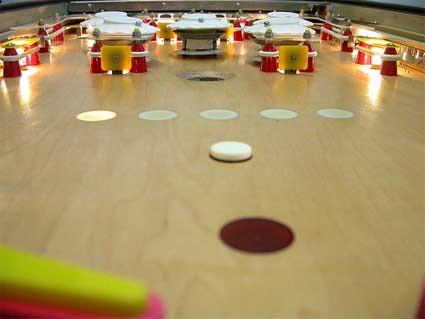
Among the many installations and documentaries i was really looking forward to see at LABoral was Bagatelle Concrete which Martin Pichlmair had mentioned a while ago in an interview i had with him.
Martin teamed up with Viennese artist and researcher Fares Kayali to turn a pinball machine from the ’70s into a musical instrument and, as he explained me at the time, The piece is a pinball machine that constructs music. It samples itself and manipulates those samples according to how you play pinball on it. We removed all competitive and all decorative elements of the pinball game and put digital electronics into this analogue electro-mechanical machine. While the gameplay is technically unaltered – all the bumpers and traps are still in place – the effect of playing is a composition instead of a highscore.
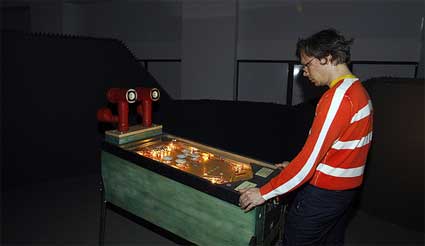 Image credit: LABoral/Enrique G. Cárdenas
Image credit: LABoral/Enrique G. Cárdenas
The more successfully the player interacts with the machine, the more intense the accompanying soundtrack gets. The piece maintains the roughness of the electromechanical original game, mixing physical sounds happening on the playing field with manipulations of their recordings.
A post written by Nicolas Nova a few days ago brought to my mind what Martin told me in Gijon when i was complaining that that damn pinball was way too difficult to play for me. Apparently the artists had to dumb down the machine. They bought it on eBay, not knowing that the ’70s model was manufactured at a time when pinballs were extremely popular and the models issued had thus to be quite high level to keep players interested.
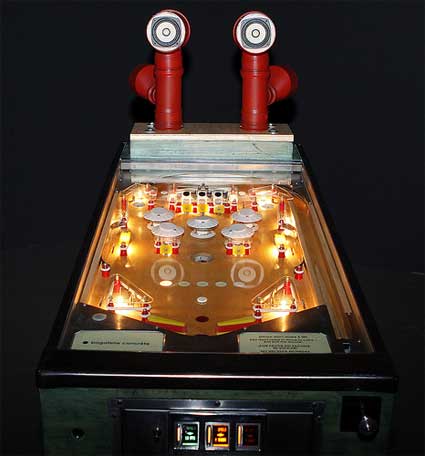 Image credit: LABoral/Enrique G. Cárdenas
Image credit: LABoral/Enrique G. Cárdenas
Concrète references musique concrète and bagatelle alludes to the history of pinball games. Bagatelle was an ancestor of modern pinball. Created in France for King louis XVI, it looked like a narrowed billiard table. The aim of the game was to get 9 balls past pins (which act as obstacles) into holes.
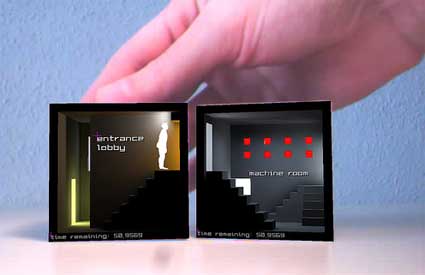 Julian Oliver is participating to the show with an improved version of levelHead, the 3D memory game became an instant youtube and blog hit the moment it hit the online turf. The installation which uses physical cubes as its only interface is totally engrossing and nerve-challenging. On screen it appears that each of the cube’s faces contains a little room and each of them is logically connected with the others by doors. In one of these rooms there is a character and by tilting the cube the player directs this character from room to room in an effort to find the way out. Some doors lead nowhere and will send the character back to the room they started in. levelHead challenges the player’s spatial memory. Each player has 120 seconds to find the exit of each cube and move the character to the next. There are three cubes (levels) in total and, the mnemonic traps become increasingly difficult to avoid as the player progresses.
Julian Oliver is participating to the show with an improved version of levelHead, the 3D memory game became an instant youtube and blog hit the moment it hit the online turf. The installation which uses physical cubes as its only interface is totally engrossing and nerve-challenging. On screen it appears that each of the cube’s faces contains a little room and each of them is logically connected with the others by doors. In one of these rooms there is a character and by tilting the cube the player directs this character from room to room in an effort to find the way out. Some doors lead nowhere and will send the character back to the room they started in. levelHead challenges the player’s spatial memory. Each player has 120 seconds to find the exit of each cube and move the character to the next. There are three cubes (levels) in total and, the mnemonic traps become increasingly difficult to avoid as the player progresses.
Video:
The game refers to one of the earliest memory systems which consisted in constructing imaginary architectures (memory loci) designed specifically for the purpose of storing information such that it could be retrieved by ‘walking through’ the building in the mind.
Today, domestic printers, digital tagging systems, address books and journals (on and offline) do the storage and indexing of information in exterior locations like remote databases or local file systems. Similarly, navigating in the real world increasingly tends toward dependence on external media and locative technologies.
With levelHead, moving from one site to another produces an imaginary architecture and positions this memory architecture as the primary means of navigation. Only one side of the cube will reveal a room at any given time and so a memory of the last room – of the positions of entrances and exits, stairs and other features – is necessary to proceed logically to the next movement.
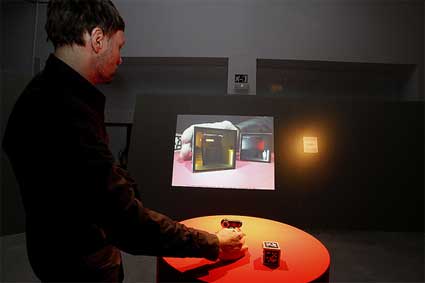 Image credit: LABoral/Enrique G. Cárdenas
Image credit: LABoral/Enrique G. Cárdenas
The tangible interface aspect is integral to the function of recall. As the cube is turned by the hands in search of correctly adjoining rooms muscle-memory is engaged and, as such, aids the memory as a felt memory of patterns of turns: “that room is two turns to the left when this room is upside down”.
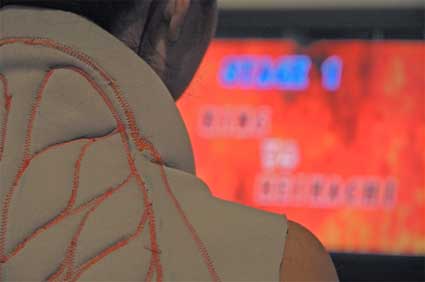
With their Massage me jackets, Hannah Perner-Wilson & Mika Satomi allow massage to enter the video game realm. The jacket is the joystick. By massaging more or less vigourously the back of a volunteer you get to control a fighting avatar. I had fun playing both roles. Being the passive massaged one is extremely relaxing as the designers had spread and repeated the commands all over the back of the jacket, focusing on the areas most likely to beg for a good rub. Now remembering where to massage in order to have your avatar jump or kick requires some practice but playing randomly will not necessarily prevent you from winning the battle.
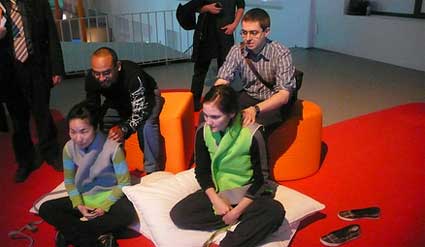 Massage Me session featuring Alessandro Ludovico, founder and editor of Neural magazine
Massage Me session featuring Alessandro Ludovico, founder and editor of Neural magazine
I’m afraid the best piece of the exhibition for me was William Wegman‘s Two Dogs and Ball (Dogs Duet). Wegman has always been a favorite of mine (has someone else seen the Deodorant video? It shows him spraying his armpit with an aerosol deodorant until the can is empty, while giving a deadpan testimonial: “It feels real nice going on, and smells good, and keeps me dry all day.”)
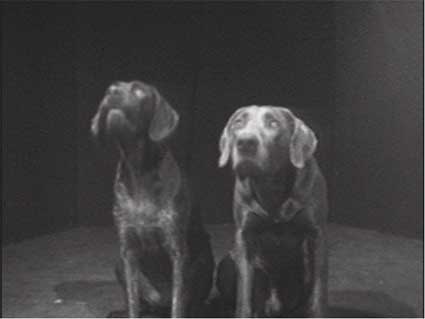
In Two Dogs and a Ball, Wegman’s Weimaraner Man Ray and his companion are mesmerized by a tennis ball which moves off screen. Wegman explained that all he had to do to obtain the comic effect was to move a tennis ball around, off-camera, thus capturing the dogs’ attention.
During the press conference, Laura Baigorri –one of the curators– explained that Wegman’s video has been selected as an example of how the avant-gardes of the 20th century had introduced an element of play in the artistic practice.
The video is on ubuweb.
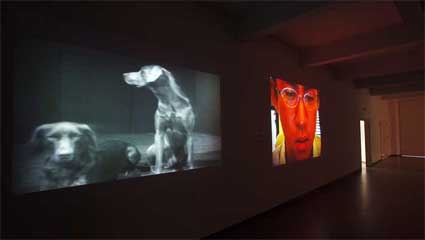 Two Dogs and Ball (Dogs Duet) and Axel Stockburger‘s Tokyo Arcade Warriors – Shibuya. Image credit: LABoral/Enrique G. Cárdenas
Two Dogs and Ball (Dogs Duet) and Axel Stockburger‘s Tokyo Arcade Warriors – Shibuya. Image credit: LABoral/Enrique G. Cárdenas
My flickr set.
HOMO LUDENS LUDENS runs at Laboral – Center for Art and Industrial Creation in Gijon, Spain (address and google map) until September 22, 2008.
Also part of the Homo Ludens Ludens exhibition: Art of War and El Burbujometro.


![7 art and tech ideas I discovered at Meta.Morf 2024 – [up]Loaded Bodies 7 art and tech ideas I discovered at Meta.Morf 2024 – [up]Loaded Bodies](https://we-make-money-not-art.com/wp-content/uploads/2024/05/53705969154_73dfdfea6f_c-300x200.jpeg)




